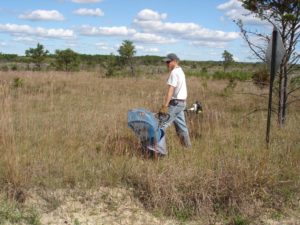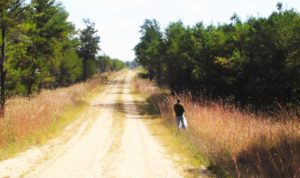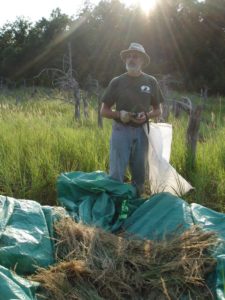Native Seed Collection in the Huron-Manistee National Forests
In 2006, Native Connections began in a multi-year collaborative effort with the US Forest Service focused on creating a local native seed source for re-vegetation projects in the Huron and Manistee National Forests in the northern Lower Peninsula of Michigan. The project entailed collecting seed of specific native grasses from wild populations throughout the National Forests, and establishing seed production plots to provide seed to the Forest Service.
2006 collections were focused on warm-season grasses, namely big bluestem (Andropogon gerardii) and little bluestem (Schizachyrium scoparium). We collected seed primarily from along roadsides and remnant pine barrens.  In 2007, we collected seed of four cool-season grasses, including poverty oatgrass (Danthonia spicata), tufted hairgrass (Deschampsia flexuosa), and junegrass (Koeleria cristata) mostly from pine barrens. We also collected seed from one wetland grass species, blue-joint grass (Calamagrostis canadensis).
In 2007, we collected seed of four cool-season grasses, including poverty oatgrass (Danthonia spicata), tufted hairgrass (Deschampsia flexuosa), and junegrass (Koeleria cristata) mostly from pine barrens. We also collected seed from one wetland grass species, blue-joint grass (Calamagrostis canadensis).
After allowing time for the collected seed to dry, it was cleaned by hand and then with a Clipper air/screen separator. Seed production plots have been established at our farm in St. Joseph County using this seed as the parent material. This has become our “USFS” sourced genotype and is a very important part of our production every year. It is grown and kept separate from our other southern Michigan genotype. Forest Service staff plan to use the seed we provide from these USFS plots to re-vegetate sites disturbed by road and other construction projects, and after wildfires and prescribed burns.
 We enjoyed the challenging work of collecting seed in the beautiful jack pine plains region of Northern Lower Michigan. It is exciting to be partners in an effort that preserves local genotypes to be used on large-scale projects. The Forest Service has been and continues to be supportive of collaborative efforts with small businesses such as Native Connections to increase the availability of native seed in Michigan.
We enjoyed the challenging work of collecting seed in the beautiful jack pine plains region of Northern Lower Michigan. It is exciting to be partners in an effort that preserves local genotypes to be used on large-scale projects. The Forest Service has been and continues to be supportive of collaborative efforts with small businesses such as Native Connections to increase the availability of native seed in Michigan.

